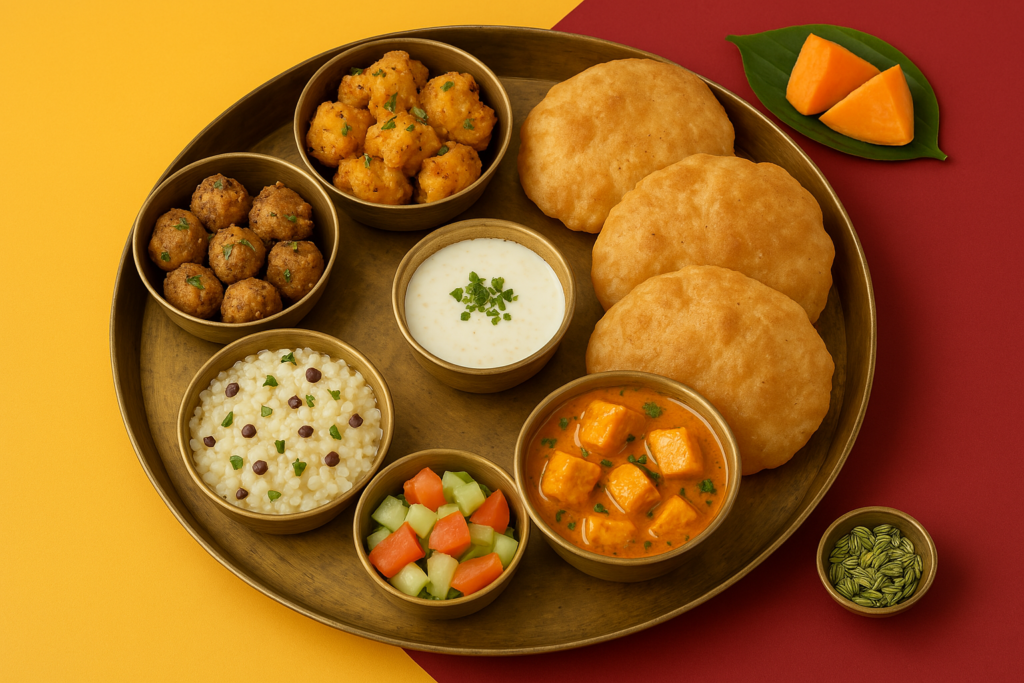Table of Contents
ToggleNavratri Food Thali – A Divine Blend of Taste, Tradition, and Health
Navratri Food Thali – A Divine Blend of Taste, Tradition, and HealthNavratri, one of the most significant and auspicious Hindu festivals, is celebrated with great devotion and enthusiasm across India. The festival, observed over nine nights, is dedicated to worshipping the nine forms of Goddess Durga. During this sacred period, devotees follow strict fasting rituals and consume only sattvic (pure) food to detoxify the body and mind. One of the most cherished aspects of this observance is the Navratri Food Thali, a carefully curated platter that combines spiritual significance with delicious, wholesome flavors.
A traditional Navratri food Thali is much more than just a meal—it’s a spiritual experience served on a plate. It includes an array of vegetarian dishes prepared without onion, garlic, or regular salt. Instead, rock salt (sendha namak) is used. Most ingredients are chosen for their lightness and digestibility, keeping in mind the body’s need for nourishment during the fast. Let’s dive into the components of a classic Navratri Thali and understand the magic behind each element.
What Makes the Navratri Thali Unique?
Unlike a regular Indian thali, the Navratri version follows specific fasting guidelines. The grains are substituted with vrat-friendly options like samak rice (barnyard millet) or kuttu atta (buckwheat flour). Legumes are avoided, and instead, potatoes, sabudana (tapioca pearls), paneer, and dairy products are extensively used. Spices are minimal but thoughtfully used to bring out the authentic flavors of each dish. Each item on the thali complements the others—offering a complete meal that’s balanced, nutritious, and deeply satisfying.
Components of a Traditional Navratri Thali
1. Sabudana Khichdi
This light and fluffy dish made from soaked tapioca pearls is a fasting staple. It is cooked with boiled potatoes, roasted peanuts, green chilies, and a tempering of cumin seeds. The dish is flavorful, easy on the stomach, and provides the body with instant energy.
2. Aloo Tamatar Curry
Potatoes simmered in a tangy tomato gravy with mild spices is a comforting and soul-satisfying dish. It is typically prepared using rock salt and a ghee-based tempering, which enhances the taste while keeping it vrat-appropriate.
3. Kuttu Ki Puri
Buckwheat flour is used to make these deep-fried puris that are crispy, tasty, and gluten-free. The dough is usually mixed with mashed potatoes to bind it together, and the puris pair wonderfully with the aloo tamatar curry.
4. Paneer Curry
Soft paneer cubes are cooked in a simple tomato-based gravy infused with black pepper and cumin. This dish provides protein and richness to the thali and is often a favorite among paneer lovers.
5. Sabudana Vada
These crunchy fritters are made from sabudana, mashed potatoes, and crushed peanuts, and are deep-fried until golden brown. They are crispy on the outside and soft on the inside, making them a delightful addition to the thali.
6. Jeera Aloo
Another potato-based delight, jeera aloo is made by sautéing boiled potatoes in ghee with cumin seeds and rock salt. It’s a quick, fuss-free recipe that adds a delicious touch to the overall meal.
7. Samak Rice (Barnyard Millet)
Replacing regular rice, samak rice is a fiber-rich, gluten-free grain that’s easy to digest. It’s boiled simply and served with a dollop of ghee. It acts as the perfect base for gravies or can be eaten on its own.
8. Cucumber-Tomato Salad
A refreshing and crunchy salad of chopped cucumbers and tomatoes, seasoned lightly with lemon juice and rock salt. It helps cool the body and adds freshness to the otherwise heavy dishes.
9. Curd (Yogurt)
Fresh homemade curd completes the meal, aiding digestion and offering a cooling contrast to the spicy and fried items. Some like to spice it up with roasted cumin powder and a hint of rock salt.
The Spiritual Significance
The Navratri Thali is not just about abstaining from certain foods—it’s a way to cleanse the body, mind, and soul. Every ingredient used is sattvic in nature, which means it promotes clarity, calmness, and positive energy. The food is usually prepared with devotion and served as an offering (bhog) to the Goddess before being consumed. This practice brings a sense of gratitude and mindfulness to the act of eating.
Health Benefits
While the Navratri Thali may appear indulgent, it’s actually quite health-focused:
Detoxifying: The ingredients used support natural detoxification.
Gluten-Free: Most dishes are made with gluten-free alternatives like kuttu and samak rice.
High in Fiber & Protein: Potatoes, paneer, and millets provide essential nutrients and energy.
Light on Digestion: No onion or garlic keeps the food light, perfect for a fasting body.
Conclusion
The Navratri Food Thali is a beautiful blend of devotion, tradition, and culinary delight. It reminds us that food can be a form of worship, and fasting doesn’t have to mean compromising on taste. Whether you’re observing the fast or simply celebrating the spirit of Navratri, indulging in a well-balanced thali is a wonderful way to embrace the season. Full of flavors, colors, and nutrition, this divine platter offers not just nourishment but also a sense of spiritual fulfillment.

